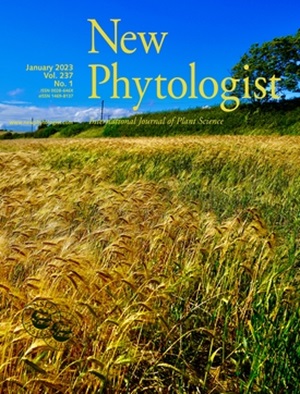植物和病原体的局部适应:柳枝草锈病的军备竞赛妥协
IF 8.1
1区 生物学
Q1 PLANT SCIENCES
引用次数: 0
摘要
在共同进化的物种中,寄生虫在当地适应宿主种群,正如宿主在当地适应抵抗寄生虫一样。由于寄生虫具有快速的生命周期,它们的适应速度往往超过宿主的局部适应速度,但宿主的多样性、选择的强度和外部环境的影响可能导致复杂的结果。为了更好地了解寄主-寄生虫系统的本地适应性,我们研究了北美一个纬度范围内的本地适应性柳枝稷(Panicum virgatum)及其叶锈病病原体(Puccinia novopanici)。我们在10个复制的多年普通花园中种植柳枝稷基因型,在“宿主互惠移植”框架中测量自然感染的锈病严重程度,以测试当地适应性。我们进行了全基因组关联定位,以确定与锈病严重程度相关的遗传位点。遗传分化的锈病种群在当地适应了北部和南部柳枝稷,尽管宿主在同一地区适应了环境条件。抗锈病是多基因性的,在北方和南方有不同的位点与锈病严重程度相关。我们将先前确定的锈病严重程度的大效应数量性状位点缩小到一个候选的YELLOW STRIPE - LIKE基因,并将许多其他位点与防御相关基因联系起来。总的来说,我们的研究结果表明,宿主和寄生虫可以同时适应当地,特别是当寄生虫施加的选择比其他环境因素少时。本文章由计算机程序翻译,如有差异,请以英文原文为准。
Local adaptation of both plant and pathogen: an arms‐race compromise in switchgrass rust
Summary In coevolving species, parasites locally adapt to host populations as hosts locally adapt to resist parasites. Parasites often outpace host local adaptation since they have rapid life cycles, but host diversity, the strength of selection, and external environmental influence can result in complex outcomes. To better understand local adaptation in host–parasite systems, we examined locally adapted switchgrass (Panicum virgatum ), and its leaf rust pathogen (Puccinia novopanici ) across a latitudinal range in North America. We grew switchgrass genotypes in 10 replicated multiyear common gardens, measuring rust severity from natural infection in a ‘host reciprocal transplant’ framework for testing local adaptation. We conducted genome‐wide association mapping to identify genetic loci associated with rust severity. Genetically differentiated rust populations were locally adapted to northern and southern switchgrass, despite host local adaptation to environmental conditions in the same regions. Rust resistance was polygenic, and distinct loci were associated with rust severity in the north and south. We narrowed a previously identified large‐effect quantitative trait locus for rust severity to a candidate YELLOW STRIPE‐LIKE gene and linked numerous other loci to defense‐related genes. Overall, our results suggest that both hosts and parasites can be simultaneously locally adapted, especially when parasites impose less selection than other environmental factors.
求助全文
通过发布文献求助,成功后即可免费获取论文全文。
去求助
来源期刊

New Phytologist
生物-植物科学
自引率
5.30%
发文量
728
期刊介绍:
New Phytologist is an international electronic journal published 24 times a year. It is owned by the New Phytologist Foundation, a non-profit-making charitable organization dedicated to promoting plant science. The journal publishes excellent, novel, rigorous, and timely research and scholarship in plant science and its applications. The articles cover topics in five sections: Physiology & Development, Environment, Interaction, Evolution, and Transformative Plant Biotechnology. These sections encompass intracellular processes, global environmental change, and encourage cross-disciplinary approaches. The journal recognizes the use of techniques from molecular and cell biology, functional genomics, modeling, and system-based approaches in plant science. Abstracting and Indexing Information for New Phytologist includes Academic Search, AgBiotech News & Information, Agroforestry Abstracts, Biochemistry & Biophysics Citation Index, Botanical Pesticides, CAB Abstracts®, Environment Index, Global Health, and Plant Breeding Abstracts, and others.
 求助内容:
求助内容: 应助结果提醒方式:
应助结果提醒方式:


